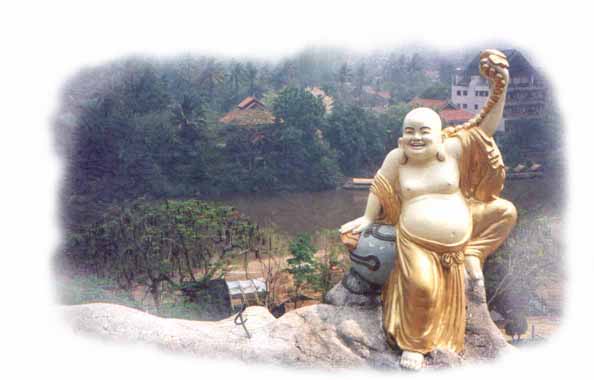|
A refreshing morning breeze blows into the car,
making my spirits soar as we travel along highway 107. The road links Chiang Mai, Mae Taeng, Chiangdao, Fang and then joins
the Fang-Thaton highway 1089.
Thaton, a small frontier town near the Thai-Burmese border
is bisected by the Kok River. It used to be the end of the road (quite literally) and the only way to Chiang Rai was a six-hour
journey by boat. Luckily, nowadays, there is a good asphalt highway linking Chiang Mai with Chiang Rai which passes through
many attractive locations.
I looked out upon the countryside of Thaton from a hilltop.
For a while, all was covered in mist until, gradually, it began to dissipate which revealed the true beauty of the landscape.
In the Mae Ai district of Chiang Mai, used to be unspoilt
and peaceful. It was a paradise for backpackers, with only a handful of guest houses which offered simple accommodation for
low-budget travellers.

Not today, the town is booming, hotels and resorts have appeared
and modern civilization is replacing the old way of living for the local people here. Expansion without control has meant
the appearance of new shop houses along the banks of the river. Concerned locals have already asked the local administration
to come and take care of this mushrooming development.
Thaton is mainly used by travellers as a short stopover, some
stay only for lunch,
or overnight before continuing on their travels to other destinations.
The backpacking set are also disappearing from Thaton, being replaced by more well-heeled tourists who come by mini-bus
or luxury coaches, complete with guides.
If you visit, dont miss Wat Thaton. From the temple verandah
there is a spectacular view of the Mae Kok river and the surrounding countryside. At the compound of Wat there are statutes
of Jow Mae Guan Im (the Goddess of Mercy) and heroes from a famous Chinese Buddhist pilgrim story such as Heng Jia the magic
monkey and the smiling Buddha. From behind the temple you can descend a staircase to the bank of the river now with lots of
shop house.

I had run out of our allotted time and could stay no longer.
I had to continue on to the Golden Triangle. However, I left Thaton full of pleasant thoughts.
Who would believe that the
island in the middle of the two mighty rivers at the Golden Triangle was once the worlds largest poppy plantation! Nowadays,
this area is famous for its remarkable natural beauty and friendly inhabitants.
On the Thai-Burma border at Mae Sai it was very hot that day
and so I decided to stop for lunch in the air-conditioned restaurant of the Wang Thong Hotel, the largest hotel in town. The
restaurant was very busy with tourists so I chose to have the set-price buffet, serving myself means you dont have to rely
on busy service staff! , a buffet cost me 100 Baht.
After I had eaten, I had time left to go and explore the market
at the border crossing. Business on the Thai side was very brisk in direct contrast to the Burmese side in Tachilek, where
things were decidedly quiet! Most of the things on sale at the border market are electronic goods made in China.
I had checked out this attraction, I left Mae Sai to drive
off to explore other area of the Golden Triangle. I covered a distance of 22 kms. and the drive took about 40 minutes.The
journey was not that interesting.
I arrived at Baan Sop Ruak, a village in the heart of the
Golden Triangle in the Chiangsaen district. This is where the borders of Thailand, Burma and Laos meet at the junction of
the Ruak and Mae Khong Rivers. In the past, the name Golden Triangle referred to a much larger area covering thousands of
square kilometers into Burma and Laos wherein the opium trade flourished.
The village street is lined with souvenir stalls, restaurants,
massage parlors, and shops selling clothing-T-shirts with maps on or poppies or the words Golden Triangle
There is a special viewing of where the two great rivers meet,
with a backdrop of the lush, forested hills of Burma and Laos. At the viewpoint is a large signpost where you can pose for
a holiday photograph. It was there that I met a group of Thai tourists sitting on the bank of the river. They were gazing
across the wide expanse of water at the other side- it was once all the same country and the people there are our blood relatives,
one remarked.
Boat-taxi were for hire to cruises around the delta or go
to the lovely, nearby town of Chiangsaen. One place I recommended visiting is the Opium Museum I think it must be the worlds
smallest museum! It has lots of historical displays pertaining to the opium industry and much more.
Late in the afternoon it was time to leave the Golden Triangle,
happy memories blotting out the infamy of the narcotics industry and its associated warlords.
Story and photographs by Gomase Theenanon
Horizons section's Bangkok Post/April 18,2002
|

